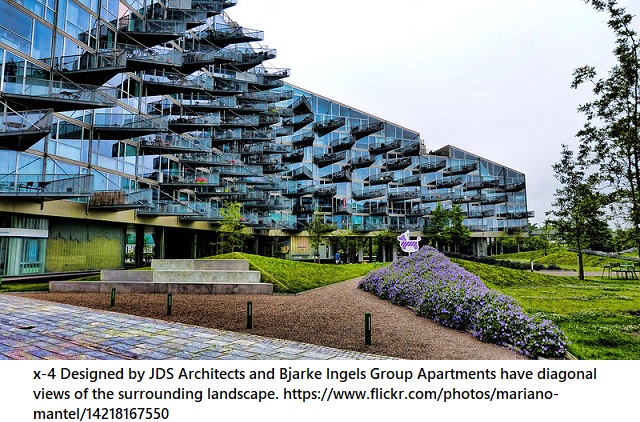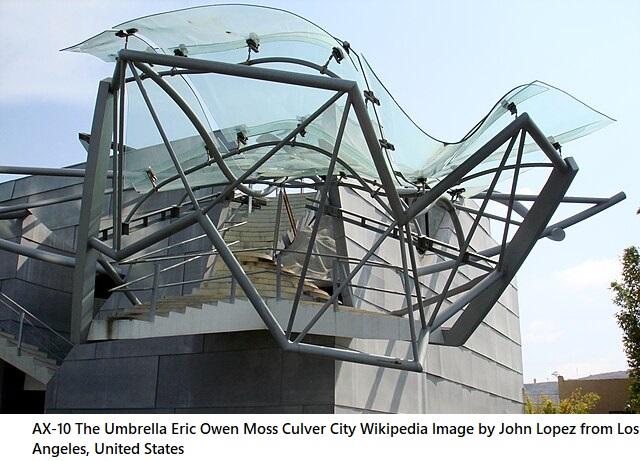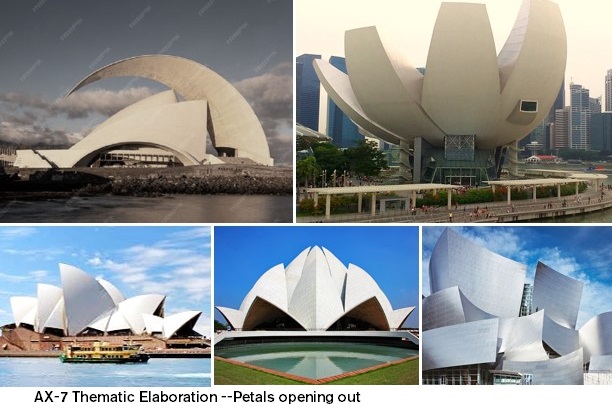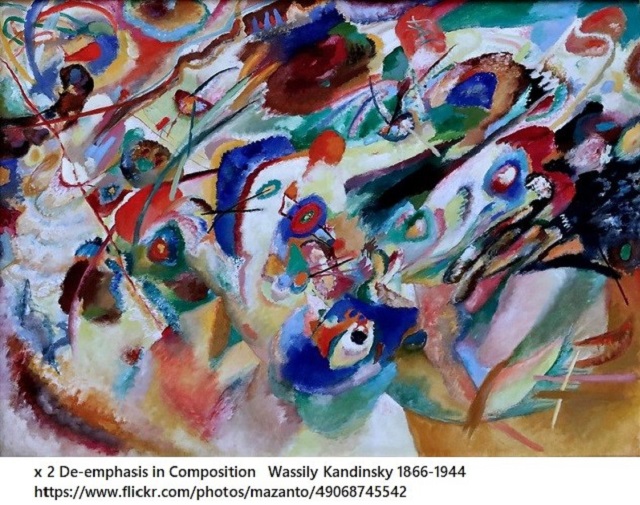Post –783 -Gautam Shah
.

These Blogs were published on https://designsynopsis.wordpress.com/
1398 De-emphasis in Design
1397 Emphasis in Design
68 Emphasis in Expression
205 Condensation and Elaboration of Content
882 Abbreviation, Condensation and Elimination in Design

1398 DE-EMPHASIS in DESIGN
If, Emphasis is distinguishing ‘few’ things in a set, de-emphasis cannot be the inversion of it, meaning not distinguishing many things. De-emphasis is to reduce the importance or prominence of things or elements. So, emphasis reflects ‘parts to the whole phenomena, but de-emphasis is not the negation or reverse of it. Emphasis is relative, a dilemmic condition.
Can de-emphasis be achieved in design, except by blinding of the perception? The ‘white spaces’ in a crowded creation like low pitch sound or silence, actionless mime or statuesque dance postures, absence arabesque in architecture, are not de-emphatic or de-stressing propositions.
‘De’, as a prefix derives from Latin de (reversing a verb’s action) =down, down from, away, off, undoing. But emphasis vs de-emphasis, is very similar to the raveling vs unraveling, both carry nearly similar actions.
De-emphasis could be a design strategy that aims to divert the attention from specific to a general or nominal situation. This could be any part of the content, shapes, colours, textures, motif, pattern, compositional value (size, scale, extent), or action enforcing buttons, etc. De-emphatic conditions aim to diffuse, discourage, avoid or delay the actions, at least for a while. De-emphasis creates a dilemma or mystery, encouraging deeper involvement, breaking of the continuity, regulations, traditions and consistency.
De-emphatic designs occur, by employing several means like, Asymmetry to challenge the Balance, Separation to counter the relationships of proximity, Breaking alliances emerging from similarity or dissimilarity, avoiding the Repetition forming familiarity, masking or camouflaging the existent Traces, such as links, implied directions, shadows, etc., managing the juxtapositions that ensue Comparisons and Contrasts.
With de-emphasis in compositions, some whites or nothingness emerges. This can be made contributory. And let the Gestaltic closure, allowing the mind to subtly bridge it.

1397 EMPHASIS in DESIGN
The emphasis in design is accidental and intentional.
Accidental emphasis is often not realized by the original designer, but, users with their intensive exposure with the entity realize it. The users, however, have few means to reinforce or de-escalate those effects. Yet if they can manage the process, it becomes mostly accidental.
Intentional emphasis reflects highly personal involvement of the designer, which may not be appreciated by the user. Users, may ‘correct’ by placing things that have greater emphasis.
Emphasis in Design, occurs through several means, like, contrast, juxtaposition, scale, position, repetition, delay, concentration, rarity, oddity, etc. Emphasis occurs by elimination or dilution of less-necessary and comparable things. The elimination of content leaves ‘white-spaces’ which can be filled in by symbols, abbreviations, surrogates or metaphors. The content to be emphasized, can have restricted exposure in time and space. Designers emphasize their input to brand their name and also achieve new insights.
Emphasis in design is used to register ephemeral matters like concepts, new ideas, narratives, anecdotes, couplets, quotations, footnotes, end-notes, linkages and other sensorial effects.
Emphasis in design is often created by de-emphasis, through elimination of introductions, details, situational connections and obvious conclusions. These create curiosity, forcing drawing of personal inferences.

68 EMPHASIS in EXPRESSION
The emphasis in presentations occurs by condensation of the subject matter.
□ Condensation eliminates all less necessary contents, and thereby increases the clarity, reduces the expression size, delivery time, perception effort, etc.
□ Condensation is also done by use of abbreviations and symbols that replace large units of contents. These include idioms, proverbs, metaphors, and signs.
□ Condensation is often used to restrict the access to a specific class of audience, like magicians’ instructions.
□ Condensation is employed to colour a document as a personal style statement.
□ Condensation processes information and makes a very abstract expression. Abstracted expressions are exploited to achieve new insights.

Elaboration is achieved by augmenting the context of difficult to understand concepts, events, situations, or objects. It is also done by using the same word in different context, and using similar words (synonyms and antonyms from a thesaurus) to redefine the meaning. Multiple explanations help amplify content. Elaboration is achieved by inclusion of anecdotes, couplets, quotations, footnotes, end notes, and other sensorial effects.
Emphasis is often created by intentional de-emphasis. Obvious details, concepts, ideas, conclusions are not put forward at the nominal time and space, but are placed at the end, or the audience is allowed to draw its own inferences.
The condensation and elaboration are employed to colour a document as a personal style statement.
Processed information often becomes so comprehensive that it becomes a very abstract expression. Abstracted expressions are exploited to achieve new insights.

882 Abbreviation, Condensation and Elimination in Design
Elimination, Abbreviation or Condensation in Design makes an expression succinct. The need first arose in writing and speech making. Writing and speech making, use poetry which cannot be impromptu or free of metaphors, so inefficient as a manner of conveyance.
A wit and proverb, both are effective, if are concise in delivery and wording. Both convey a larger meaning in shortest time and with smallest content. In courts, public forum discussions, this was a good practice.
Just to be brief, in time (delivery) and space (content), people first resort to Condensation through scaling. Scaling includes faster delivery of speech, writing in smaller or closer fonts, expression with use of complex Mudras or transient gestures in dance or drama, finer motifs and complex patterns in crafts and buildings.
Detailing the content using Abbreviations like symbols, metaphors, matrices, elaborations and external reinforcements.
For Briefness, the next manner is to exploit the intervening time and space, like pauses in speech, interim quietude, ‘white spaces, transparencies, spatial distancing, etc.
Elimination of the useless, occurs only as an exercise on hindsight, after substantial creation already in place. One begins to strip away, but without losing the essential purpose and identity. The nett result is paintings, sculptures, buildings, furniture, garments, products are redesigned and redefined. There is often lack of any strategy or justification. After the elimination, contents largely miss out on the conveyance (of idea).

205 CONDENSATION and ELABORATION of CONTENT
We primarily express, to communicate and record our experiences. Both of these processes are about recollection and re-enactment. These also help us to organize everything to a concept and recover the missing sets of information. Communication imparts information to someone, or secures a reaction, whereas Recording organizes the information for posterity.
■ Condensation of Content:
Condensation eliminates all unnecessary and less necessary contents, and thereby increase the clarity, reduces the size of expression, delivery or transmission time and effort required for perception. Condensation is also done with use of abbreviations and symbols that replace large units of contents. These include idioms, proverbs, metaphors, and signs. Condensation is often used to restrict the access to a specific class of audience, like magicians’ instructions.
■ Elaboration of Content:
Elaboration is achieved by augmenting the context of difficult to understand concepts, events, situations, or objects. It is also done by using the same word in different context, and using similar words (synonyms and antonyms from a thesaurus) to redefine the meaning. Multiple explanations help amplify the content. Elaboration is also achieved by inclusion of anecdotes, couplets, quotations, footnotes, end notes, and other sensorial effects.
■ Emphasis:
The Emphasis occurs by both condensation and elaboration of the subject matter. Condensation and elaboration, both are employed to colour a document as a personal style statement. Emphasis is often created by intentional de-emphasis. Obvious details, concepts, ideas, conclusions are not put forward at the nominal time and space, but are placed at the end, or the audience is allowed to draw its own inferences.

.